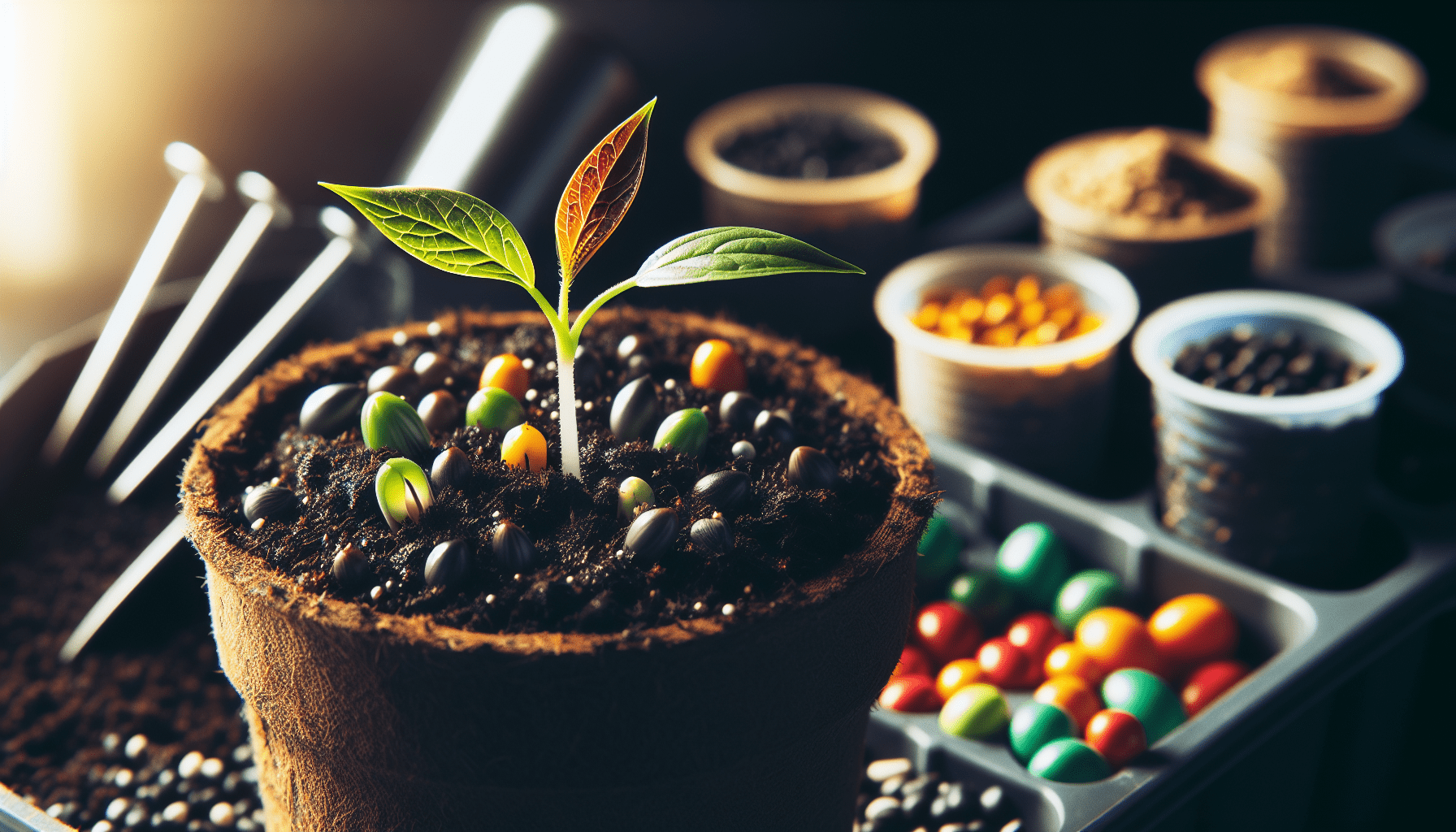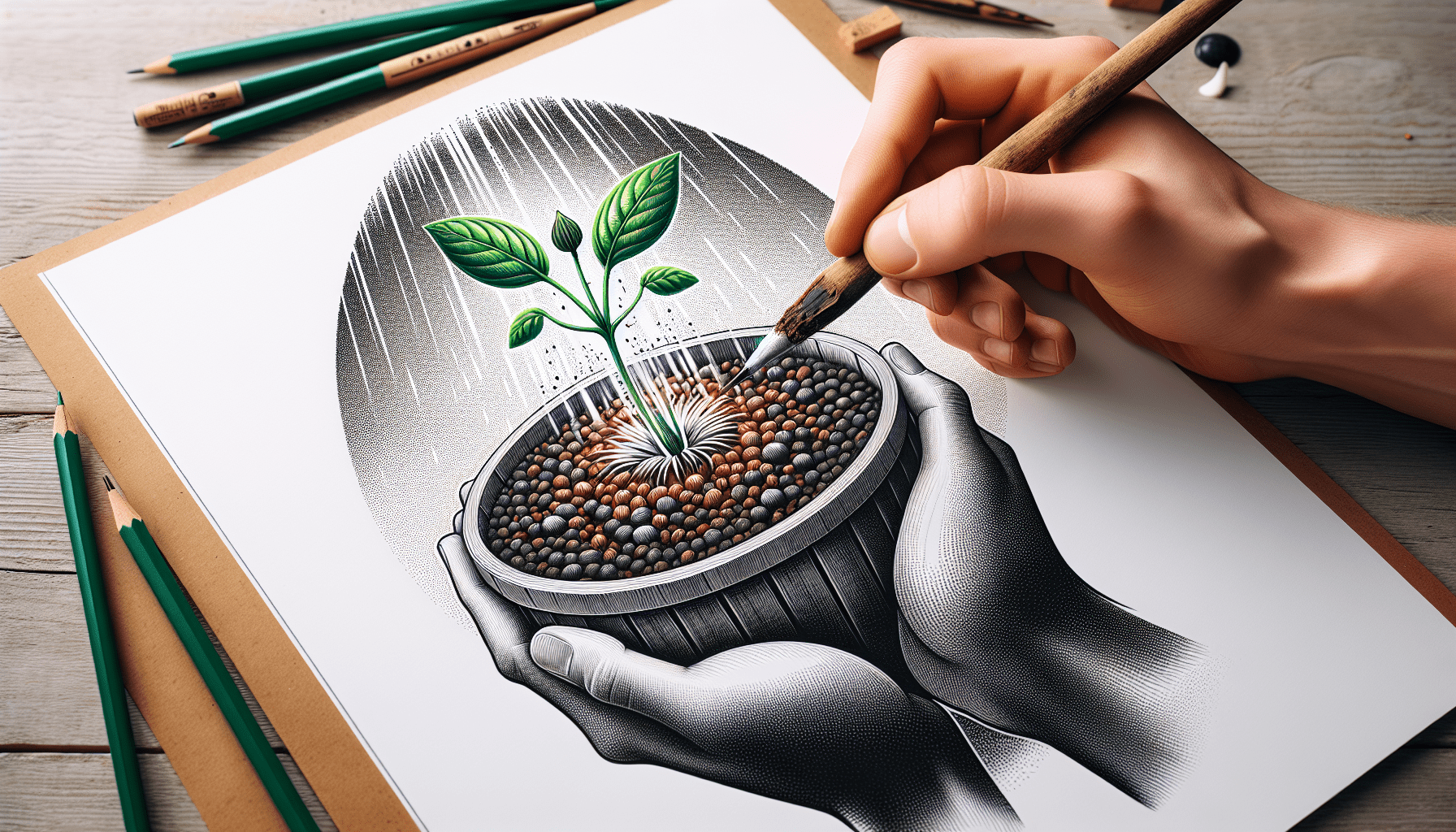This post may contain affiliate links which means I may receive a commission for purchases made through links. Learn more on my Private Policy page.
If you’re interested in cultivating your own plants at home, starting seeds indoors can be a great way to get a head start on the gardening season. Whether you’re a seasoned pro or a beginner, this article will provide you with the best practices for successfully starting seeds indoors. From choosing the right containers and soil, to providing adequate lighting and watering, these tips will help you ensure healthy seedlings that will thrive once transplanted outdoors. Get ready to embark on a rewarding and fruitful gardening journey with these tried-and-true techniques!
Choosing the Right Containers
Consider container sizes
When starting seeds indoors, it is important to choose the right containers. Consider the size of the containers and whether they can accommodate the grown plants. Larger plants may require bigger containers, while smaller plants can thrive in smaller pots. Ensure that the containers have enough space for the plant’s roots to grow and spread.
Ensure adequate drainage
Drainage is essential for the health of your plants. Choose containers that have drainage holes at the bottom to allow excess water to flow out. This helps prevent waterlogging, which can lead to root rot and other problems. If your chosen container does not have drainage holes, you can add them by creating small openings using a drill.
Select biodegradable or reusable containers
Consider using biodegradable or reusable containers when starting seeds indoors. Biodegradable containers such as pots made from peat or coconut coir are environmentally friendly and can be directly planted into the ground when it is time to transplant. Reusable containers, such as plastic pots or trays, can be used year after year and are a more sustainable option.
Use trays or domes for seedlings
To create a suitable microclimate for seedlings, it is beneficial to use trays or domes. Trays can hold multiple pots or cells, making it easier to water and transport the seedlings. Domes can be placed on top of the trays to create a mini greenhouse effect, trapping heat and moisture. This helps maintain a stable environment for germination and growth.
Preparing the Growing Medium
Opt for seed starting mix
Using a high-quality seed starting mix is essential for successful seed germination. Seed starting mixes are specially formulated to provide the right balance of nutrients, moisture retention, and aeration for young seedlings. They are typically soilless and sterile, reducing the risk of diseases and pests.
Sterilize the growing medium
Before planting your seeds, it is important to sterilize the growing medium. Sterilization helps eliminate any potential pathogens or weed seeds that could harm your seedlings. To sterilize the growing medium, you can bake it in the oven at a low temperature or heat it in the microwave. Alternatively, you can purchase pre-sterilized seed starting mixes.
Provide proper moisture levels
Seeds require a moist environment to germinate, but excessive moisture can lead to fungal diseases and damping-off. Ensure that the growing medium is evenly moist, but not soaking wet. Avoid overwatering, as it can cause the seeds to rot. Using a spray bottle or misting wand can help control the moisture levels and provide a gentle misting of water.
Consider adding nutrients
While seed starting mixes contain some nutrients, they may not be sufficient for the entire seedling stage. Consider adding a diluted fertilizer solution or organic amendments to provide the necessary nutrients for healthy growth. However, be careful not to over-fertilize, as this can damage the delicate seedlings. Follow the manufacturer’s instructions for proper application.

Selecting the Right Seeds
Choose high-quality seeds
The success of your indoor seed starting venture greatly depends on the quality of the seeds you choose. Look for seeds from reputable sources or seed companies that have a good track record. High-quality seeds have a higher germination rate, ensuring a greater chance of success. Pay attention to the seed packaging, which should include information about the seed variety, its origin, and expiration date.
Select seeds suitable for indoor starts
Not all seeds are suitable for indoor starting. Some plants may be better suited for direct sowing in the garden. Choose seeds that have a shorter germination period and faster growth rate, making them more suitable for indoor growing. Leafy greens, herbs, and flowers are often good candidates for indoor seed starting.
Consider your climate and grow zone
Consider your climate and the grow zone you are in when selecting seeds. Some plants have specific temperature and light requirements. Choose seeds that are suitable for your climate and can thrive indoors. If you are unsure, refer to the plant hardiness zone map to determine which seeds are best suited for your area.
Check seed viability
Before planting your seeds, it is advisable to check their viability. Older seeds or those that have been improperly stored may have a lower germination rate. Conduct a simple germination test by placing a few seeds on a moist paper towel and sealing them in a plastic bag. Keep the bag in a warm location and check regularly for germination. This will give you an idea of how many viable seeds you have and will help you adjust your planting quantity if needed.
Providing Suitable Lighting
Choose the right lighting system
Proper lighting is crucial for healthy seedling growth. If you are not able to provide adequate natural light, consider using artificial lighting systems. LED grow lights or fluorescent lights are excellent options for indoor seed starting. Make sure to place the lights at the correct distance from the seedlings to prevent burning or stretching of the plants.
Consider natural light sources
If possible, take advantage of natural light sources for your seedlings. Place your seedlings near a south-facing window or another sunny location. This will provide them with the necessary intensity and spectrum of light for photosynthesis. Rotating the containers regularly ensures that all sides of the seedlings receive equal light exposure.
Provide adequate light duration
Seedlings require approximately 12-16 hours of light per day for optimal growth. If using artificial lighting, set a timer to mimic natural daylight hours. This helps ensure that the seedlings receive consistent and sufficient light. Adequate light duration promotes strong and sturdy growth, preventing seedlings from becoming thin or weak.
Use reflective surfaces
To maximize the use of light, consider using reflective surfaces around your seedlings. This can be as simple as lining the walls around your seed starting area with aluminum foil or white sheets. Reflective surfaces bounce the light back onto the plants, making the most of the available light source.

Maintaining Optimal Temperature and Humidity
Provide consistent warmth
Seeds and seedlings thrive in a warm environment. Provide consistent warmth by placing your seed containers or trays on a heat mat specifically designed for seed starting. Heat mats gently warm the growing medium, promoting quicker germination and root development. Make sure to monitor the temperature to avoid overheating or causing temperature fluctuations.
Use heat mats or thermostats
Heat mats alone may not be enough to regulate temperature variations. To ensure optimum conditions, use a thermostat in conjunction with your heat mat. This allows you to set and maintain a specific temperature, ensuring a consistent and ideal environment for seed germination and seedling growth.
Maintain proper humidity levels
Humidity plays a vital role in seed germination and seedling development. To maintain proper humidity levels, consider placing a tray filled with water near your seedlings. As the water evaporates, it increases the humidity in the immediate vicinity. Alternatively, you can use a humidifier to control and maintain the desired humidity level.
Create a mini greenhouse environment
Creating a mini greenhouse environment can help maintain optimal temperature and humidity for your seeds and seedlings. This can be achieved by covering your seed containers or trays with a clear plastic dome or using plastic wrap. The covering traps heat and moisture, creating a more stable and controlled environment conducive to germination and early growth.
Implementing Proper Watering Techniques
Water seeds from the bottom
When watering your seeds, it is recommended to water them from the bottom. This encourages deep root growth and prevents excessive moisture on the plant’s leaves. Place your seed containers in a tray and pour water into the tray. The soil will absorb the water through capillary action, ensuring the roots have access to moisture.
Use a fine mist sprayer
For delicate seedlings, a fine mist sprayer is the preferred method of watering. This helps prevent disturbance to the delicate roots and minimizes the risk of overwatering. Mist the soil surface gently, ensuring that it is evenly moist. Avoid spraying directly on the seedlings to prevent damage.
Avoid overwatering
Overwatering is one of the most common mistakes when starting seeds indoors. It can lead to fungal diseases, root rot, and poor seedling growth. Allow the top layer of soil to dry out slightly between watering sessions. Stick your finger into the soil to test its moisture level. If it feels overly damp, hold off on watering until the soil has dried out a bit.
Monitor moisture levels closely
Seedlings have specific moisture requirements, and it is vital to monitor the soil moisture levels closely. Using a moisture meter or simply observing the appearance and feel of the soil can help determine when watering is necessary. Remember that different plants may have different moisture requirements, so adjust your watering frequency accordingly.
Practicing Adequate Ventilation
Allow for air circulation
Proper ventilation is important for seedlings to prevent diseases and promote strong growth. Allow for adequate air circulation by placing a small fan near your seedlings, set on a low speed. This gentle breeze helps strengthen the stems and prevents damp conditions that can lead to mold or fungal issues.
Use fans for gentle breeze
If natural air circulation is limited, you can also use fans to provide a gentle breeze. Position the fans to blow across the seedlings, making sure the air movement is not too strong or directly on the plants. This mimics outdoor conditions and helps prevent leggy growth caused by stagnant air.
Open vents to regulate temperature
If using a mini greenhouse or a clear plastic cover, make sure to open the vents regularly to regulate temperature and humidity. This allows fresh air to circulate and prevents excessive condensation. Monitor the conditions inside the enclosure and adjust the vents accordingly to maintain optimum growing conditions.
Prevent fungal diseases
Good ventilation is crucial for preventing fungal diseases such as damping-off. Adequate air movement helps dry the soil surface, preventing the growth of mold and pathogens. By practicing proper ventilation, you can reduce the risk of seedling diseases and ensure their overall health and vigor.
Caring for Germinating Seeds
Remove seed covers or husks
Once your seeds have germinated, it is important to remove any seed covers or husks that may still be attached to the seedlings. These coverings can impede the growth of the emerging plant and may cause it to become distorted or weakened. Gently remove the covers using tweezers or your fingers, taking care not to damage the delicate seedling.
Protect against damping-off disease
Damping-off is a fungal disease that can affect young seedlings. To protect against damping-off, avoid overwatering and provide proper ventilation. This helps prevent the growth of mold and fungi that can cause the disease. If necessary, use a fungicide specifically formulated for seedlings to further protect against damping-off.
Thin out overcrowded seedlings
If you notice that your seedlings are growing too closely together or overcrowded, it is essential to thin them out. Overcrowding can lead to stunted growth and competition for resources. Carefully remove the weaker seedlings, leaving only the strongest and healthiest ones. This ensures that each seedling has enough space to grow and develop properly.
Avoid touching fragile seedlings
When caring for germinating seeds, it is important to handle them delicately and avoid touching the fragile seedlings as much as possible. Excessive handling can damage the tender leaves and stems, hindering growth and potentially introducing pathogens. When moving or transplanting seedlings, always hold them by the leaves or use a tool such as a spoon to avoid direct contact with the delicate stems.
Transplanting Seedlings into Larger Containers
Wait for true leaves to form
Before transplanting your seedlings into larger containers, it is crucial to wait until the true leaves have formed. True leaves are the second set of leaves that emerge after the sprouting of the initial cotyledon leaves. These leaves closely resemble the mature leaves of the plant and indicate that the seedling is ready for transplantation.
Handle seedlings delicately
When transplanting seedlings, it is important to handle them delicately to avoid damaging the roots or disturbing the growth. Hold the seedlings by their leaves or use a spoon to gently lift them out of their original containers. Minimize any root disturbance and make sure to plant the seedlings at the same depth they were growing previously.
Use proper transplanting technique
To transplant seedlings, create holes in the growing medium of the larger containers using a dibber or your fingers. Place the seedlings in the holes, ensuring that the roots are covered and the soil is firm around the base. Gentle watering after transplanting helps settle the soil and encourages the seedlings to establish themselves in their new containers.
Provide gradual acclimation to outside conditions
If you plan to eventually move your seedlings outdoors, it is essential to provide them with a gradual acclimation process. This helps the seedlings adjust to the outdoor conditions, such as temperature, light intensity, and wind. Start by placing the seedlings in a sheltered spot outdoors for a few hours a day, gradually increasing the exposure over the course of a week or two.
Monitoring and Preventing Common Seedling Problems
Inspect for pests and diseases
Regularly inspect your seedlings for any signs of pests or diseases. Look for chewed leaves, discoloration, or wilting. Common pests that affect seedlings include aphids, fungus gnats, and spider mites. If you notice any issues, take immediate action by using organic insecticidal soaps or appropriate pest control methods to prevent further damage.
Prevent leggy seedlings
Leggy seedlings occur when they stretch or reach toward a light source that is not close enough. To prevent leggy seedlings, make sure the light source is positioned at the correct distance and provide adequate light duration. Additionally, proper air circulation and ventilation can help strengthen the stems and prevent excessive stretching.
Address nutrient deficiencies
Monitor your seedlings closely for any signs of nutrient deficiencies. Yellowing leaves, stunted growth, or purpling of the leaves may indicate a lack of essential nutrients, such as nitrogen, phosphorus, or potassium. Depending on the deficiency, adjust your fertilizer application or consider using organic amendments to provide the necessary nutrients for healthy growth.
Prevent transplant shock
Transplant shock can occur when seedlings are not properly acclimated to changes in environmental conditions. To prevent transplant shock, ensure that seedlings are well-hydrated before transplanting and handle them gently to minimize root disturbance. Provide adequate moisture and avoid exposing the seedlings to extreme temperatures or direct sunlight immediately after transplanting.
Starting seeds indoors can be a rewarding experience, allowing you to get a head start on your garden and ensure successful plant growth. By following these best practices for choosing containers, preparing the growing medium, selecting the right seeds, providing suitable lighting, maintaining optimal temperature and humidity, implementing proper watering techniques, practicing adequate ventilation, caring for germinating seeds, transplanting seedlings into larger containers, and monitoring and preventing common seedling problems, you can set yourself up for healthy and thriving plants. Remember to enjoy the process and be patient, as growing seeds indoors requires attention and dedication. Happy gardening!
This post may contain affiliate links which means I may receive a commission for purchases made through links. Learn more on my Private Policy page.

